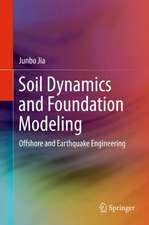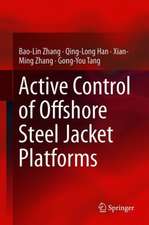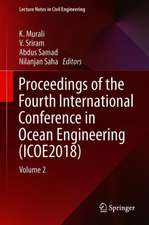Proceedings of the 25th Pan-American Conference of Naval Engineering—COPINAVAL
Editat de Adán Vega Sáenz, Newton Narciso Pereira, Luis Manuel Carral Couce, José Angel Fraguela Formosoen Limba Engleză Hardback – 4 iul 2018
The 2017 congress was held in Panama City, Panama, bringing together a select group of scientists, entrepreneurs, academics and professionals to discuss the latest technological advances in the maritime industry.
| Toate formatele și edițiile | Preț | Express |
|---|---|---|
| Paperback (1) | 954.14 lei 6-8 săpt. | |
| Springer International Publishing – 2 ian 2019 | 954.14 lei 6-8 săpt. | |
| Hardback (1) | 960.30 lei 6-8 săpt. | |
| Springer International Publishing – 4 iul 2018 | 960.30 lei 6-8 săpt. |
Preț: 960.30 lei
Preț vechi: 1171.10 lei
-18% Nou
Puncte Express: 1440
Preț estimativ în valută:
183.75€ • 192.37$ • 152.04£
183.75€ • 192.37$ • 152.04£
Carte tipărită la comandă
Livrare economică 05-19 aprilie
Preluare comenzi: 021 569.72.76
Specificații
ISBN-13: 9783319898117
ISBN-10: 3319898116
Pagini: 490
Ilustrații: XXIV, 473 p. 191 illus., 161 illus. in color.
Dimensiuni: 155 x 235 mm
Greutate: 0.87 kg
Ediția:1st ed. 2019
Editura: Springer International Publishing
Colecția Springer
Locul publicării:Cham, Switzerland
ISBN-10: 3319898116
Pagini: 490
Ilustrații: XXIV, 473 p. 191 illus., 161 illus. in color.
Dimensiuni: 155 x 235 mm
Greutate: 0.87 kg
Ediția:1st ed. 2019
Editura: Springer International Publishing
Colecția Springer
Locul publicării:Cham, Switzerland
Cuprins
1. Naval Engineering
1.1. Structural parametric model of an ecological and efficient shuttle tanker for operations at the Brazilian pre-salt region
1.2. Effect of Encountered Wave Condition on Fatigue Life Prediction of Ship Structures
1.3. Comparison of the performance of a sea-based radars
1.4. Low draught small steel working multi hull vessels, a study of five cases
1.5. Numerical Model to Analyse a SNCR System to Reduce NOx
1.6. Structural parametric model of an ecological and efficient shuttle tanker for operations at the Brazilian pre-salt region
1.7. Prediction of welded structures distortion due to straightening using inherent strain method
1.8. Failure probability assessment to design a solid circular shaft under torsional moment applying Monte Carlo method
1.9. Hydrodynamic Analysis and Propulsive Arrangement of two Corvette Hulls with Different Operational Profiles
1.10. Equivalent SPS Compact Double Hull (CDH) Bottom Structure Grounding of Inland Waterway Barges
2. Marine Transportation and Logistics
2.1. Using the cabotage potential for the installation of a green freight corridor
2.2. Alternative route with integrated road-water transportation system between Ananindeua/Marituba to the Federal University of Para, Brazil
2.3. Integrated Planning Tool for Ubu Port Operations - A Case Study at Samarco Mining
2.4. Study of Sustainable Maritime Transport on the Brazilian Coast - Green Corridor
2.5. Integrated transportation system under seasonality effects
2.6. Analysis of Sustainable Logistics Operations: A Roadmap for Port Santos in Brazil
2.7. Analysis of the efficiency of port companies through a method of support for decision making: Analysis of Brazilian companies
3. Marine Sustainability
3.1. The use of low carbon technology in maritime industry as alternatives to climate change
3.2. Review of renewable energies for naval propulsion and its application in the national fleet
3.3. Environmental Impact of an Ex-Landfill on an Estuary
3.4. Advantages of using solar energy in Brazilian public ports
3.5. Statistical Methods for Automatic Seabed Identification
4. Marine Corrosion
4.1. Synthesis and Characterization of Hydrophobic Coatings for the Control of Corrosion in Marine Environments
4.2. Experiences in the application of the norm of yield of the protective coatings of the tanks dedicated to ballast
4.3. Replacement of Zinc Anodes for Aluminum Indium Zinc Anodes, in the Chilean Navy
5. Maritime Legal Aspects
5.1. The Obligation of Seaworthiness: Ship-owner and Charterer
5.2. Seaworthiness and Major Accidents at Sea - An International Perspective
6. Offshore Technologies
6.1. Hydrodynamic analysis of a duct laying vessel
6.2. Variables for the assembly of the Topside on the Jacket in the most southern platform of the World in Argentina
6.3. Aerodynamic analysis of an FPSO vessel using numerical simulation (CFD)
7. Marine Maintenance
7.1. Capacity-Based Planning (PBC) for the promotion of competitiveness in the Shipyard Industry
7.2. High resistance concrete and steel manway for oil terminal
7.3. Management of occupational risk prevention in construction and repair yards
1.1. Structural parametric model of an ecological and efficient shuttle tanker for operations at the Brazilian pre-salt region
1.2. Effect of Encountered Wave Condition on Fatigue Life Prediction of Ship Structures
1.3. Comparison of the performance of a sea-based radars
1.4. Low draught small steel working multi hull vessels, a study of five cases
1.5. Numerical Model to Analyse a SNCR System to Reduce NOx
1.6. Structural parametric model of an ecological and efficient shuttle tanker for operations at the Brazilian pre-salt region
1.7. Prediction of welded structures distortion due to straightening using inherent strain method
1.8. Failure probability assessment to design a solid circular shaft under torsional moment applying Monte Carlo method
1.9. Hydrodynamic Analysis and Propulsive Arrangement of two Corvette Hulls with Different Operational Profiles
1.10. Equivalent SPS Compact Double Hull (CDH) Bottom Structure Grounding of Inland Waterway Barges
2. Marine Transportation and Logistics
2.1. Using the cabotage potential for the installation of a green freight corridor
2.2. Alternative route with integrated road-water transportation system between Ananindeua/Marituba to the Federal University of Para, Brazil
2.3. Integrated Planning Tool for Ubu Port Operations - A Case Study at Samarco Mining
2.4. Study of Sustainable Maritime Transport on the Brazilian Coast - Green Corridor
2.5. Integrated transportation system under seasonality effects
2.6. Analysis of Sustainable Logistics Operations: A Roadmap for Port Santos in Brazil
2.7. Analysis of the efficiency of port companies through a method of support for decision making: Analysis of Brazilian companies
3. Marine Sustainability
3.1. The use of low carbon technology in maritime industry as alternatives to climate change
3.2. Review of renewable energies for naval propulsion and its application in the national fleet
3.3. Environmental Impact of an Ex-Landfill on an Estuary
3.4. Advantages of using solar energy in Brazilian public ports
3.5. Statistical Methods for Automatic Seabed Identification
4. Marine Corrosion
4.1. Synthesis and Characterization of Hydrophobic Coatings for the Control of Corrosion in Marine Environments
4.2. Experiences in the application of the norm of yield of the protective coatings of the tanks dedicated to ballast
4.3. Replacement of Zinc Anodes for Aluminum Indium Zinc Anodes, in the Chilean Navy
5. Maritime Legal Aspects
5.1. The Obligation of Seaworthiness: Ship-owner and Charterer
5.2. Seaworthiness and Major Accidents at Sea - An International Perspective
6. Offshore Technologies
6.1. Hydrodynamic analysis of a duct laying vessel
6.2. Variables for the assembly of the Topside on the Jacket in the most southern platform of the World in Argentina
6.3. Aerodynamic analysis of an FPSO vessel using numerical simulation (CFD)
7. Marine Maintenance
7.1. Capacity-Based Planning (PBC) for the promotion of competitiveness in the Shipyard Industry
7.2. High resistance concrete and steel manway for oil terminal
7.3. Management of occupational risk prevention in construction and repair yards
Notă biografică
Dr. Adan Vega Saenz is a mechanical engineer with a Master degree in materials science and a another one in plant engineering, all from the Technological University of Panama. He holds a PhD in marine engineering from Osaka University, Japan He is author of more than fifty scientific articles and a textbook. Dr. Vega's professional experience includes, among others, being a university professor for fifteen years at the Technological University of Panama, visiting professor at the Technological University of Bolivar and UNINORTE, both in Colombia. Academic vice president and Research Vice president at International Maritime University of Panama. Consultant of several national and international companies.
Newton Narciso Pereira joined the Fluminense Federal University (UFF), Rio de Janeiro - Brazil, - School of Metallurgical Industrial Engineering of Volta Redonda (EEIMVR) in 2016. In 2014 he completed his postdoc in Naval Architecture and Ocean Engineering focusing on ballast water management and control in Brazilian ports. He holds a Doctor and Master degrees in Naval Architecture and Ocean Engineering from the Polytechnic School of University of São Paulo. He is graduate in Naval Technology from Faculdade de Tecnologia de Jahu – UNESP and Production Engineering from Guarulhos University. He is general coordinator of Center for Sustainable System Studies (CESS-UFF) and graduate coordinator of Production Engineering course at (EEIMVR).
Dr. Luis Carral Couce holds a Ph.D. in Naval Architecture and Marine Engineering from the Universidad Politécnica de Madrid (Technical University of Madrid) and a Master’s degree in Maritime Law and Port Administration from the University of La Coruna (Spain). He previously worked at the former Spanish Navy shipyard of Bazan (now Navantia) prior to joining the faculty as a professor at the EPS-Ferrol, which is part of the University of La Coruna (Spain), where he continues to teach and conduct research. As a faculty specialist in Maritime Transport and Ship Auxiliary Systems he is part of the university’s Multidisciplinary Research Group (GEM). He has developed several post-graduate degree programmes at the university, including in Design, Production and Inspection of Sailing and Recreational Watercraft and Maritime Logistics and Transport. In addition, he has been the Chairman of the Spanish Association of Naval Architects in the region of Galicia for several years.
Dr. José Angel Fraguela PhD in Naval Architecture and Marine Engineering. Professor at the University of A Coruña (Spain). Director, organizer, speaker in numerous masters, expert courses, specialization courses, technical conferences in Europe and Latin America. Author of numerous books and technical articles in JCR journals and other databases. Director of numerous PhD and Final Degree Projects. Member of Scientific Committees, peer reviewer and editor in International and National Congresses. President of the IPIN-SPAIN (Pan-American Institute of Naval Engineering). Member of the Consultative Council of IPIN-AMERICA.
Newton Narciso Pereira joined the Fluminense Federal University (UFF), Rio de Janeiro - Brazil, - School of Metallurgical Industrial Engineering of Volta Redonda (EEIMVR) in 2016. In 2014 he completed his postdoc in Naval Architecture and Ocean Engineering focusing on ballast water management and control in Brazilian ports. He holds a Doctor and Master degrees in Naval Architecture and Ocean Engineering from the Polytechnic School of University of São Paulo. He is graduate in Naval Technology from Faculdade de Tecnologia de Jahu – UNESP and Production Engineering from Guarulhos University. He is general coordinator of Center for Sustainable System Studies (CESS-UFF) and graduate coordinator of Production Engineering course at (EEIMVR).
Dr. Luis Carral Couce holds a Ph.D. in Naval Architecture and Marine Engineering from the Universidad Politécnica de Madrid (Technical University of Madrid) and a Master’s degree in Maritime Law and Port Administration from the University of La Coruna (Spain). He previously worked at the former Spanish Navy shipyard of Bazan (now Navantia) prior to joining the faculty as a professor at the EPS-Ferrol, which is part of the University of La Coruna (Spain), where he continues to teach and conduct research. As a faculty specialist in Maritime Transport and Ship Auxiliary Systems he is part of the university’s Multidisciplinary Research Group (GEM). He has developed several post-graduate degree programmes at the university, including in Design, Production and Inspection of Sailing and Recreational Watercraft and Maritime Logistics and Transport. In addition, he has been the Chairman of the Spanish Association of Naval Architects in the region of Galicia for several years.
Dr. José Angel Fraguela PhD in Naval Architecture and Marine Engineering. Professor at the University of A Coruña (Spain). Director, organizer, speaker in numerous masters, expert courses, specialization courses, technical conferences in Europe and Latin America. Author of numerous books and technical articles in JCR journals and other databases. Director of numerous PhD and Final Degree Projects. Member of Scientific Committees, peer reviewer and editor in International and National Congresses. President of the IPIN-SPAIN (Pan-American Institute of Naval Engineering). Member of the Consultative Council of IPIN-AMERICA.
Textul de pe ultima copertă
This book presents selected contributions to the Pan-American Congress of Naval Engineering, Maritime Transport and Port Engineering (COPINAVAL), which is in its twenty-fifth edition and has become a reference event for the global maritime and port sector, attracting more and more participants from different countries.
The 2017 congress was held in Panama City, Panama, bringing together a select group of scientists, entrepreneurs, academics and professionals to discuss the latest technological advances in the maritime industry.
The 2017 congress was held in Panama City, Panama, bringing together a select group of scientists, entrepreneurs, academics and professionals to discuss the latest technological advances in the maritime industry.
Caracteristici
Presents the latest advances in the maritime sector
Provides a discussion forum with leading experts from the Americas, Asia and Europe
Contributes to upholding the conference’s fifty-year tradition as the most attractive event in the maritime sector
Provides a discussion forum with leading experts from the Americas, Asia and Europe
Contributes to upholding the conference’s fifty-year tradition as the most attractive event in the maritime sector









